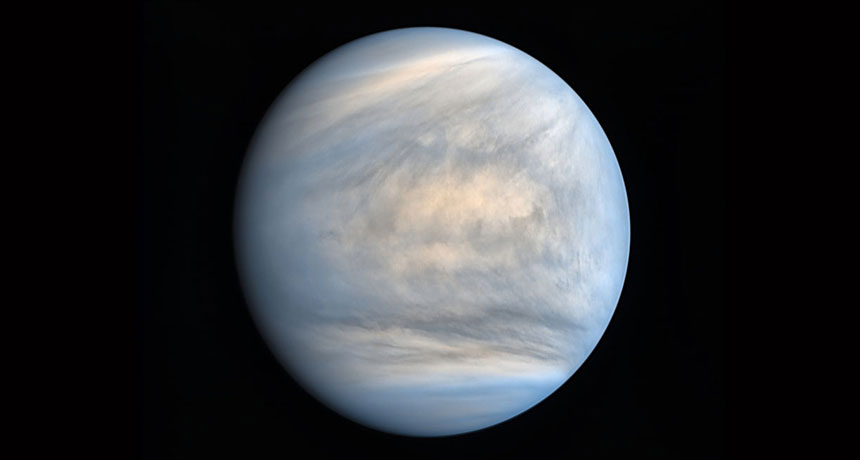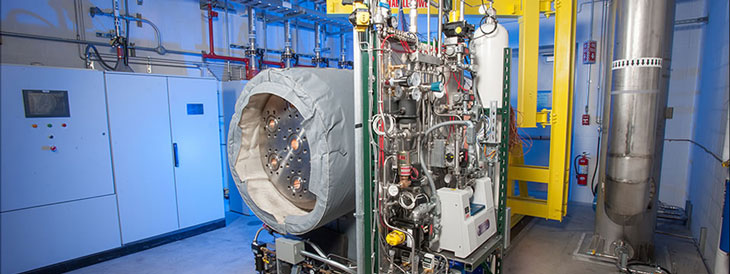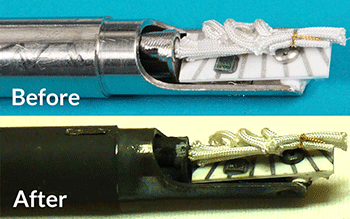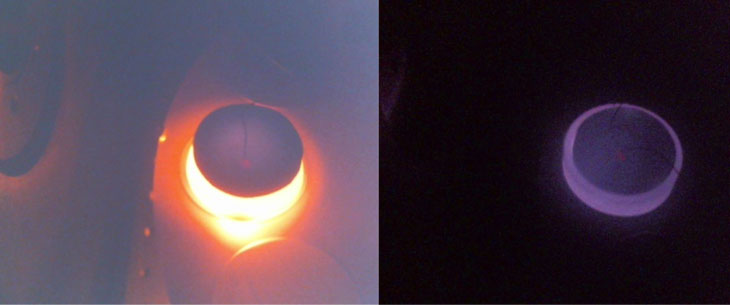Here’s why Venus is so unwelcoming
The planet is scorching hot and its pressure extreme, but engineers are homing in on the tech to probe it

Akatsuki spacecraft images show a cloud-covered atmosphere similar to Earth’s. Those clouds hide a hostile surface.
Damia Bouic/DARTS/ISAS/JAXA
There’s a planet next door that could explain the origins of life in the universe. It was probably once covered in oceans. It may have been able to support life for billions of years. No surprise, astronomers are desperate to land spacecraft there.
The planet is not Mars. It’s Earth’s twin, Venus.
Despite its appeal, the second planet from the sun is one of the hardest places in the solar system to get to know. That’s partly because modern Venus is famously hellish. Temperatures are hot enough to melt lead. Choking clouds of sulfuric acid swirl through its atmosphere.
Today, researchers who want to explore Venus say they have the technology to master such challenging conditions. “There’s a perception that Venus is a very difficult place to have a mission,” says Darby Dyar. She is a planetary scientist at Mount Holyoke College in South Hadley, Mass. “Everybody knows about the high pressures and temperatures on Venus, so people think we don’t have technology to survive that. The answer is that we do.”
Indeed, researchers are actively developing Venus-defying technology.
In 2017, there were five proposed Venus projects. One was a mapping orbiter. It would probe the atmosphere as it fell through it. Others were landers that would zap rocks with lasers. From a technology point of view, all were considered ready to go. And the laser team actually got money to develop some parts for the system. But the other programs failed to find funding.
“Earth’s so-called ‘twin’ planet Venus is a fascinating body,” notes Thomas Zurbuchen. He is the associate administrator for NASA’s science mission programs in Washington, D.C. The problem, he explains, is that “NASA’s mission selection process is highly competitive. By that he means that right now there are more good ideas than money available to build them all.
Story continues below image.

Visiting Venus
In the search for alien life, Venus and Earth would look equally promising from afar. Both are roughly the same size and mass. Venus lies just outside the sun’s habitable zone. That zone has temperatures that could keep liquid water stable on a planet’s surface.
No spacecraft have landed on the surface of Venus since 1985. A few orbiters have visited Earth’s neighbor in the past decade. The European Space Agency’s Venus Express was one. It visited Venus from 2006 to 2014. The other is the Japanese space agency’s Akatsuki. It has been orbiting Venus since December 2015. Still, no NASA craft has visited Earth’s twin since 1994. That’s when the Magellan craft plunged into the atmosphere of Venus and burned up.
One obvious barrier is the planet’s thick atmosphere. It is 96.5 percent carbon dioxide. That blocks scientists’ view of the surface in almost all wavelengths of light. But it turns out that the atmosphere is transparent to at least five wavelengths of light. That transparency could help identify different minerals. And Venus Express proved it would work.
Looking at the planet in one infrared (In-frah-RED) wavelength allowed astronomers to see hot spots. These might be signs of active volcanoes. An orbiter that used the other four wavelengths might learn even more, Dyar says.
Ground truth
To really understand the surface, scientists want to land a craft there. It would have to contend with the opaque atmosphere while looking for a safe place to touch down. The best map of the planet’s surface is based on radar data from Magellan a quarter century ago. Its resolution is too low to show rocks or slopes that might topple a lander, notes James Garvin. He works at NASA’s Goddard Space Flight Center in Greenbelt, Md.
Garvin is part of a team that’s testing a computer-vision technique. Called Structure from Motion, it could help a lander map its own touch-down site. It would do this during its descent. The system quickly analyzes many images of stationary objects taken from different angles. This allows it to create a 3-D rendering of the surface.
Garvin’s group tried it out with a helicopter over a quarry in Maryland. It was able to plot boulders less than half a meter (19.5 inches) across. That’s about the size of a basketball hoop. He is scheduled to describe the experiment in May at the Lunar and Planetary Science Conference in The Woodlands, Texas.
Any lander that survives to reach the surface of Venus faces another challenge: surviving.
The first landers there were Soviet spacecraft. They landed in the 1970s and 1980s. Each lasted only an hour or two. That’s not surprising. The planet’s surface is about 460° Celsius (860° Fahrenheit). The pressure is some 90 times that of Earth’s at sea level. So in short order some crucial component will melt, become crushed or corrode in the acidic atmosphere.
Modern missions are not expected to fare much better. It could be one hour — or maybe 24 hours “in your wildest dreams,” Dyar says.
But a team at NASA’s Glenn Research Center in Cleveland, Ohio is hoping to do far better. It aims to design a lander that would last months. “We’re going to try to live on the surface of Venus,” explains Tibor Kremic. He is an engineer at the Glenn center.
Past landers have used their bulk to temporarily absorb heat. Or they have countered scorching temps with refrigeration. Kremic’s team proposes something new. They plan to use simple electronics. Made of silicon carbide, these should withstand the heat and do a reasonable amount of work, says Gary Hunter. He is a NASA Glenn electronics engineer.

His group has tested the circuits in a Venus simulation chamber. Called GEER, it’s short for Glenn Extreme Environment Rig. Kremic compares it to “a giant soup can.” This one has walls 6 centimeters (2.4 inches) thick. The new type of circuits still worked after 21.7 days in an atmosphere that simulated Venus.
The circuits could have lasted longer, Hunter suspects, but didn’t get a chance. Scheduling issues put an end to the test.
The team now hopes to build a prototype lander that would last for 60 days. On Venus, that would be long enough to act as a weather station. “That has never been done before,” Kremic notes.
Reading rocks
And that presents the next challenge. Planetary scientists have to figure out how to interpret such data.
Rocks interact with the Venusian atmosphere differently than they would with the surface atmosphere on Earth or Mars. Mineral specialists identify rocks based on the light they reflect and emit. But the light that a rock reflects or emits can change in high temperatures and pressures. So even when scientists get data from the rocks on Venus, understanding what they show could prove tricky.
Why? “We don’t even know what to look for,” Dyar admits.
Ongoing experiments at GEER will help here. Scientists can leave rocks and other materials in the chamber for months, then see what happens to them. Dyar and her colleagues are doing similar experiments in a high-temperature chamber at the Institute of Planetary Research in Berlin.
Story continues below image.

“We try to understand the physics of how things happen on the Venus surface so we can be better prepared when we explore,” Kremic says.
There are other ways to explore rocks, too. Two approaches NASA didn’t yet fund would use different techniques. One would maintain Earthlike conditions inside, then bring crushed rocks into a chamber for study. Another shoots rocks with a laser, then analyzes the resulting puff of dust. The Mars Curiosity rover uses this technique.
But their high costs are putting some planned tests on indefinite hold. Last year, NASA issued a research challenge. It is looking for candidate missions to Venus that could get there for $200 million or less.
“The Venus community is torn on this idea,” Dyar says. It would be hard to make meaningful headway on science questions at such a low cost, she notes. Still, she concedes, it may take multiple piecemeal missions to understand Venus anyway. “We’ll get the frosting on one trip and the cake on a different trip.”
Lori Glaze works on a Venus project at NASA Goddard. “My new favorite saying for the Venus community,” she says, is “Never give up, never surrender.” So, she notes, “We keep trying.”







